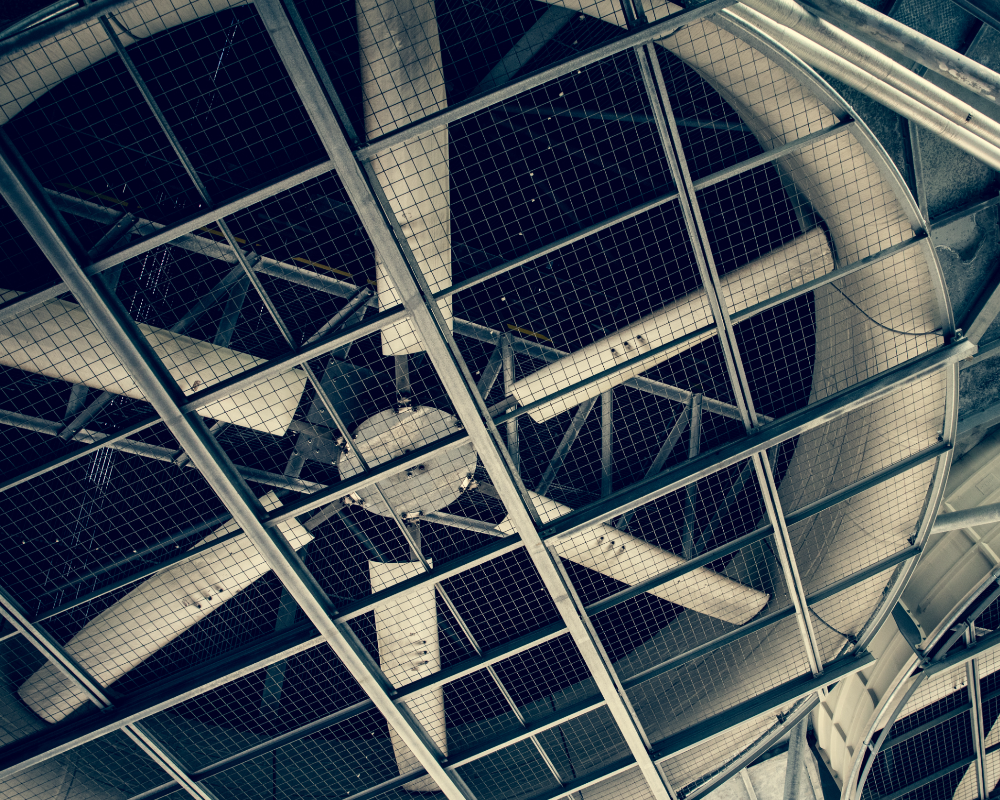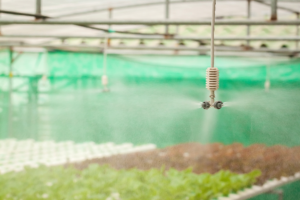Welcome! In this article, we’re cutting straight to the chase and exploring the ins and outs solar-powered greenhouse fans. So, if you’re ready, let’s begin. First, let’s recap the importance of your greenhouse environment. Remember, greenhouses create optimal growing conditions for plants by harnessing sunlight to maintain warm internal temperatures and protect plants from external weather conditions. However, this controlled environment can often become too hot or humid for plants to thrive. This is where solar powered fans come into play. By circulating air and regulating temperature, these fans help to prevent plant stress caused by excessive heat and moisture buildup.
As a greenhouse owner, you understand the importance of maintaining a stable environment for your plants. Solar powered greenhouse fans present a sustainable solution, converting the sun’s energy into electricity to power ventilation systems without the need for external electrical sources. This not only reduces energy costs but also ensures that your greenhouse remains operational even in the event of power outages.
The installation and operation of solar powered fans are relatively straightforward. These fans consist of a solar panel, a battery to store energy, and the fan itself. During the day, the solar panel captures sunlight and either directly powers the fan or charges the battery, which can then be used to keep the fan running during the night or on cloudy days. With no ongoing energy costs and minimal maintenance required, solar powered fans are an efficient and eco-friendly option to keep your greenhouse in prime condition.
Understanding Solar-Powered Greenhouse Fans
Greenhouse fans are crucial for maintaining optimal growing conditions by regulating temperature and airflow. Solar-powered options offer an eco-friendly approach to this essential task.
Basics of Solar-Powered Greenhouse Fans
Solar-powered greenhouse fans operate using energy harnessed from the sun through solar panels. These fans do not rely on conventional electricity, making them renewable and sustainable options. Your greenhouse fans can work throughout the day using direct sunlight, and with the proper setup, during the night with stored power.
Importance of Ventilation and Air Circulation
Proper ventilation and air circulation are fundamental to plant health in your greenhouse. Efficient solar-powered fans facilitate constant airflow, preventing the buildup of hot and humid air which can lead to plant diseases. These fans ensure there is uniform temperature distribution across the entire space.
Benefits of Eco-Friendly Solutions
Choosing solar-powered fans reflects a commitment to sustainability. By using renewable energy, you decrease the greenhouse’s carbon footprint and promote an eco-friendly environment, contributing positively to broader climate change efforts.
Types of Solar Panels for Greenhouse Fans
For greenhouse applications, photovoltaic (PV) solar panels are commonly used. The quality of the solar panel influences the system’s efficiency. Monocrystalline panels are highly efficient, while polycrystalline panels provide a more cost-effective solution, yet with lower efficiency.
Considering the Size and Power Output
Selecting the correct size and power output is imperative to meet your greenhouse’s ventilation needs. A small greenhouse might only need a 10W fan, while larger structures may require 50-watt or even 70-watt fans. This decision is guided by the volume of air that needs to be circulated to effectively regulate temperature.
Energy Efficiency and Climate Considerations
In summer, high temperatures can be mitigated by efficient solar-powered fans without the added energy costs. Your choice should take into account climate conditions and the greenhouse’s energy needs to ensure the system is capable of maintaining a stable growing environment.
Durability and Warranty Factors
Durability is a key consideration, as the solar-powered fans must withstand various weather conditions. A good quality fan will come with a warranty, assuring you of its longevity and performance. Always check for the warranty period and what it covers before purchase.
Selecting the Right Solar-Powered Fan for Your Greenhouse
Choosing the correct solar-powered fan for your greenhouse ensures efficient airflow and temperature control. Remember that your selection should focus on the fan size, airflow capacity, essential features, and performance analysis.
Assessing Size and Airflow Needs
To determine the appropriate size for a solar-powered fan in your greenhouse, you must consider the volume of your space. For example, a small greenhouse typically up to 2250 square feet would require a different fan size than larger structures. The goal is to achieve maximal airflow which can be estimated by calculating the cubic feet of your greenhouse and ensuring the fan can exchange the air at least once per minute.
| Greenhouse Volume (Cubic Feet) | Recommended Airflow (CFM) |
|---|---|
| Up to 1,000 | 1,000 CFM |
| 1,001 – 2,250 | 2,250+ CFM |
| 2,251+ | Assess per individual case |
Features of the Best Solar-Powered Greenhouse Fans
When evaluating the best solar-powered greenhouse fans, look for units with a durable build and weatherproofing qualities. Models like the ‘Amtrak Solar Powerful 50-Watt Solar Attic Fan’ or the ‘SUN Energise Solar Powered Exhaust Fan Pro’ typically boast features that ensure longevity and performance. Additionally, consider ease of installation, adaptable mounting options, and whether the fan has integrated batteries for nighttime operation.
Key Features to Consider:
- Durable construction
- Weather resistance
- Integrated battery backup
- Efficient solar panels
- Warranty and support
Comparative Analysis
It’s important to assess user reviews and ratings to gauge the overall satisfaction with solar fan performance. For example, the ‘AntPay 10W Weatherproof Dual Fan’ might have positive reviews for its effectiveness in small greenhouses. In contrast, the ‘GBGS Solar Powered Exhaust Fan’ might be preferred in larger setups due to its superior power. A side-by-side comparison of top models based on user feedback, energy efficiency, and price gives you a comprehensive understanding of which fan aligns with your needs.
| Model | User Rating | Airflow (CFM) | Best Suited Greenhouse Size (Sq. Ft.) |
|---|---|---|---|
| Amtrak Solar Attic Fan | 4.5/5 | 2250+ | Up to 2250 |
| SUN Energise Exhaust Fan Pro | 4/5 | Varies | Small to Medium |
| AntPay Weatherproof Dual Fan | 4.2/5 | Moderate | Up to 1200 |
| GBGS Solar Exhaust Fan | 4.6/5 | 1750 | 1200 – 2250 |
Installation and Operation
When installing and operating a solar-powered greenhouse fan, your focus should be on the proper mounting for optimal airflow, ensuring correct wiring for connectivity, regular maintenance to prevent issues, and understanding thermostat controls for automated operation.
Mounting and Placement
Proper Mounting: To ensure ease of installation and optimal operation, mount your solar-powered fan at a high point opposite the greenhouse door. This placement facilitates a unidirectional flow of air, which helps in maintaining consistent temperatures.
- Orientation: Position the solar panel where it will receive maximum sunlight, usually facing south in the Northern Hemisphere.
Wiring and Connectivity
Wiring Details: Secure the wiring from the solar panel to the fan, avoiding locations where it can be damaged. Use weatherproof wiring and connectors to prevent short circuits due to moisture.
- Connectivity: For an automatic shrink valve design, connect the valve’s wires according to the manufacturer’s instructions to ensure it operates correctly with the fan.
Maintenance and Troubleshooting
Regular Checks: Maintenance should be simple. Regularly clear any debris from the solar panel and check the fan for obstructions to maintain smooth operation.
- Troubleshooting Steps:
- Verify all connections.
- Check the fan blades for blockages.
- Inspect the solar panel’s surface cleanliness.
Understanding Controls and Thermostats
Thermostat Use: Familiarize yourself with the thermostat. An adjustable thermostat will allow you to set the desired temperature for automatic fan operation.
- Automatic Operation: A correctly installed thermostat will enable your solar-powered fan to start and stop based on temperature changes, optimizing the greenhouse climate without manual intervention.
Extended Uses and Versatility
Solar-powered fans offer a sustainable and adaptable solution for various settings beyond the greenhouse. They thrive in diverse environments and come equipped with advanced features to meet your specific needs.
Multi-Environment Suitability
Your solar-powered fan is not just for greenhouses. Attics and sheds, often subject to extreme heat, can greatly benefit from the airflow these fans provide, keeping these areas cool and well-ventilated. For outdoor enthusiasts, bringing a solar fan to a camping trip ensures comfort away from the electrical grid. These fans are typically made with waterproof materials like premium ABS and tempered glass, ensuring durability in different weather conditions.
- Attics: Reduces heat buildup, prevents moisture-related damage.
- Sheds: Protects equipment/tools from rust and mold due to excess heat and humidity.
- Camping: Offers a portable, eco-friendly cooling system.
Integrated Features and Technologies
Your solar-powered fan may come with integrated lights, providing multi-functional value. The fan blades are designed for maximum airflow. They are paired with a high-speed DC fan motor, which operates efficiently and quietly. The core of the system is a high-efficiency solar panel, capable of converting sunlight into electricity even on overcast days. This technology emphasizes the product’s versatility, backed by its robust build suitable for various applications.
- Lights: LED lights for added illumination.
- Fan blades: Aerodynamically designed for optimal air movement.
- Solar panel: Built with efficiency in mind; often housed in sturdy tempered glass.
- High-Speed DC Fan: Provides significant air circulation with minimal noise.
Impact of Solar-Powered Fans on Plant Growth
Installing solar-powered fans in greenhouses positively affects plant growth by stabilizing environmental conditions and improving air quality. You’ll see how these improvements directly translate to healthier and more robust plants.
Enhancing Plant Growth Environment
Consistent airflow from solar-powered fans ensures that your plants receive a steady supply of carbon dioxide, crucial for photosynthesis. By circulating air, these fans help maintain even indoor temperatures, preventing hotspots that can stress plants. A well-designed fan system can lead to a more uniform light distribution, aiding in uniform plant growth throughout your greenhouse.
Controlling Humidity and Temperature
Balanced humidity levels are vital for preventing plant diseases and fostering healthy plant growth. Solar-powered fans play a key role in managing humidity by expelling excess moisture and bringing in drier air when necessary. Additionally, proper ventilation helps regulate temperature, reducing the risk of heat stress on your plants during warmer months. Here’s a simple overview:
- Humidity management: Reduces high moisture that can lead to mold and mildew.
- Temperature control: Helps avoid extremes, keeping the greenhouse within optimal growth range.
Air Quality and Pest Control
Improved air circulation through solar-powered fans also impacts air quality by dispersing carbon dioxide evenly across the plant canopy, promoting better growth. The movement of air can deter flying pests, contributing to pest control and minimizing the need for chemical treatments. A clean and controlled air environment is less hospitable to pests and more conducive to the growth of healthy plants.
- Air circulation: Disperses CO2 and reduces layering of gases.
- Pest deterrence: Movement of air acts as a physical barrier to pests.
Cost Considerations and Saving Potential
When considering solar-powered fans for your greenhouse, it’s crucial to evaluate both the initial setup costs and the potential savings. These savings are realized primarily through reduced energy bills and the investment value over time.
Reducing Energy Bills
By integrating solar-powered fans into your greenhouse, you transition from conventional energy sources to solar energy, which is abundant and free after installation costs. This results in a direct decrease in your monthly energy bills. The amount you save depends on several factors such as the size of the greenhouse, local energy prices, and the efficiency of the fans you select. For instance, if your conventional electrical fan costs $30 monthly to operate, and a solar fan has negligible operational costs post-installation, you save that amount each month.
Long-Term Savings and Investment

Solar-powered fans represent a long-term investment, where the initial cost is offset by the sustainability benefits and energy savings over time. The upfront cost can vary, typically ranging from $100 to $500 per unit, depending on the fan’s capacity and features. However, considering energy savings and minimal maintenance, solar fans can pay for themselves. For example, a solar fan costing $200 and saving you $30 monthly would pay for itself in under seven months, and continue to provide cost benefits for years.
Consumer Resources
When selecting a solar-powered fan for your greenhouse, it’s essential to consider factors like efficiency, fitting kits, and specific operational metrics.
Buying Guide for Solar-Powered Greenhouse Fans
To choose the right fan, first, determine the ventilation needs of your greenhouse based on its size and plant types. Look for a fan with adequate cubic feet per minute (CFM) output to ensure proper air circulation. The CFM rating indicates the volume of air the fan can move per minute, which is critical for maintaining an ideal temperature and humidity level.
Key features to consider:
- CFM: Match your greenhouse size to the fan’s CFM rating.
- RPM (Revolutions per Minute): Higher RPMs can indicate more effective air movement.
- Noise Level: Opt for fans that advertise quiet operation to avoid disruptive sounds.
Assessing Solar Panel Output:
- Ensure the solar panel provided can sufficiently power the fan during peak sun hours. Panels are rated in watts, with higher figures offering more power.
Advantages of Kits and Accessories
Purchasing a kit can streamline the installation process and ensure that all components are compatible. Kits often come with mounting brackets, wiring, and additional controls for ease of use.
What to look for in a Kit:
- Complete Package: Confirm that the kit includes all necessary parts.
- Ease of Installation: Kits should offer user-friendly instructions.
- Additional Features: Some kits include thermostats or speed controllers, providing more precise management of greenhouse conditions.
Assessment of Product Specifications
Evaluating the specifications of a solar-powered fan ensures that it meets the specific requirements of your greenhouse. Pay close attention to the CFM rating and ensure that it aligns with your space’s size to promote optimal air exchange.
Specifications Table:
| Feature | Why It Matters |
|---|---|
| CFM | Determines the air exchange rate; vital for plant health and pest control. |
| RPM | Higher RPMs can lead to better air circulation. |
| Noise Level | Low noise levels are preferable to minimize disruption. |
| Warranty | Look for products with a warranty for peace of mind and reliability. |
Check if the system has speed variability, as different plants and seasons may require different ventilation rates. A solar fan that cannot adjust to these changes may be less efficient.
Conclusion
When considering climate control in your greenhouse, solar-powered fans emerge as a practical solution. They harness sunlight to operate, thereby reducing electricity costs and promoting renewable energy use. The installation of such fans ensures a continuous flow of air, crucial for plant health by curbing mold, mildew, and other moisture-related issues.
Advantages:
- Cost-effective: Once installed, they require little to no operating expenses.
- Eco-friendly: Utilizes sustainable energy, cutting down carbon footprint.
- Low maintenance: Solar fans generally require minimal upkeep.
Considerations:
- Positioning: Ensure optimal sunlight exposure for the solar panels.
- Capacity: Choose a model that suits the size and ventilation needs of your greenhouse.
Employing solar-powered fans contributes to an energy-efficient greenhouse, aligning with both economic savings and environmental stewardship. As you harness the sun’s power, your greenhouse thrives, reflecting a commitment to smart, sustainable agricultural practices.
Frequently Asked Questions
In this FAQ section, you’ll find concise answers to common questions about solar-powered fans for greenhouses, offering clarity on their operation, installation, and benefits.
What are the best solar-powered fans for greenhouses currently on the market?
The market offers several high-quality options, such as the Amtrak Solar Powerful 70-Watt Galvanized Steel Solar Fan and the Eco-Worthy Solar Powered Attic Ventilator. These models are well-regarded for their efficiency and reliability in maintaining optimal greenhouse conditions.
How do solar-powered greenhouse fans with thermostats work?
Solar-powered fans with thermostats use solar panels to convert sunlight into electricity, which powers the fan motor. The thermostat monitors the temperature within the greenhouse, activating the fan to ventilate when the internal temperature exceeds a pre-set benchmark, thereby maintaining the desired climate.
Can you install a solar-powered fan for a greenhouse by yourself?
Yes, you can install a solar-powered fan yourself if you have basic DIY skills and tools. Most kits come with comprehensive instructions. However, for optimal performance and safety, following the manufacturer’s guidelines and local building codes is advised.
What are the pros and cons of using a solar fan for greenhouse ventilation?
Pros include reduced energy costs, environmental sustainability, and low maintenance. Cons might be the initial setup cost and the dependency on sunlight for optimal operation. A solar fan for greenhouse ventilation fosters a sustainable, self-regulating environment beneficial for plant growth.
Is it necessary to use a fan in a greenhouse, and if so, how does solar power enhance its functionality?
It’s necessary to use a fan for proper ventilation, which helps regulate temperature and humidity, prevent disease, and ensure healthy plant growth. Solar power enhances functionality by providing a cost-effective, renewable source of energy, reducing grid dependency and operational costs.
What are the efficiency levels of 12-volt solar-powered fans for greenhouses?
12-volt solar-powered fans are designed to be energy-efficient, typically operating at high efficiency levels with adequate sunlight. Their efficiency can vary depending on the fan model and the quality of the solar panel but generally are effective in maintaining greenhouse circulation without incurring electricity costs.






